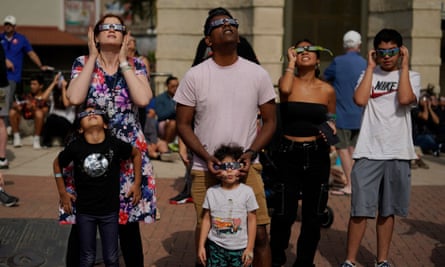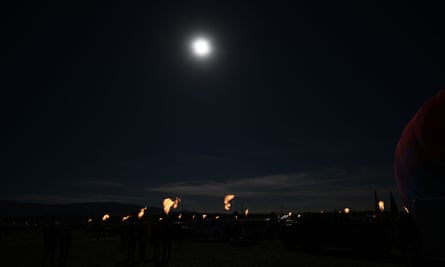It was a moment that won’t happen again for 16 years – and Mother Nature obscured it in some places.
“It was supposed to be sunny in Corpus Christi today and now is clouds everywhere. Trying to see where we have to drive to,” one frustrated eclipse viewer in Texas posted on the Total Solar Eclipse 2024 Facebook page. (The title references next April’s total eclipse, which will be visible in some areas of the US.)
In the small towns and cities along the eclipse’s narrow path, there was a mix of excitement, worries about the weather, and concerns they’d be overwhelmed by visitors flocking to see the celestial event, also called an annular solar eclipse. Clouds and fog threatened to obscure the view of the eclipse in some western states, including California and Oregon.

As totality began in Eugene, Oregon, oohs and ahs combined with groans of disappointment as the eclipse became only intermittently visible, the sun’s light poking through cloud cover from behind the moon only at times.
I always say it is better to be lucky than good, but I made my own luck this morning.
— Chris Pietsch (@ChrisPietsch) October 14, 2023
Still can’t believe I got a peek. Covered by clouds until it wasn’t!
More of the annular eclipse from around Oregon at https://t.co/4aFBEc3229#SolarEclipse2023 #SolarEclipse @registerguard pic.twitter.com/JEAIZ2GAqx
Elsewhere in Texas, the weather was clear as children at a lively watch party in Kerrville counted down to the moment the moon passed fully in front of the sun, and cheered loudly when it did.
In New Mexico, the sky was crystal-clear, giving tens of thousands of spectators an unfettered view. They got a double treat since the eclipse coincided with an international balloon fiesta that draws close to 100,000 spectators for early morning mass ascensions of hundreds of colorful hot air balloons.

Organizers gave out 80,000 pairs of viewing glasses Saturday morning. There were hoots, hollers and yelps as the ring formed and hot air balloon pilots used their propane burners to shoot flames upward.
#RingofFire #Eclipse 10:28 MT from East Mountains, New Mexico pic.twitter.com/LZikkgxaAL
— Joline Gutierrez Krueger 🤦🏾♀️🖋🗒👩🏽💻📰🇺🇦 (@jolinegkg) October 14, 2023
Nasa livestreamed the event from Albuquerque, documenting the gasps and cheers that could be heard as annularity was reached. “We’re in annularity. It is a gorgeous sight to behold,” said Michael Kirk, a heliophysicist at Nasa.
Annularity during a solar eclipse is the moment when the moon is fully in front of the sun, creating the ring of fire that was the highlight of today’s eclipse. It lasts for only a few minutes.

Allan Hahn of Aurora, Colorado, has attended the festival for 34 years, first as a crew member and then as a licensed balloon pilot. His balloon, Heaven Bound Too, was one of 72 selected for a special “glow” performance as skies darkened during the eclipse.
“It’s very exciting to be here and have the convergence of our love of flying with something very natural like an eclipse,” he said.
The celestial event brought eclipse watchers from around the US to remote corners of the country to try to get the best view possible. At Bryce Canyon national park in southern Utah, tiny lights could be seen along a well-known trail that snakes through a valley of red rock hoodoos as eclipse enthusiasts hit the trail before sunrise to stake out their preferred spots in nooks and crannies along the way.
“I just think it’s one of those things that unites us all,” said John Edwards, a cancer drug developer who traveled alone across the country to try to watch the eclipse from Bryce Canyon. “I just think it’s seeing these unique experiences that come rarely is what got me here. This is about as rare as it gets.”










